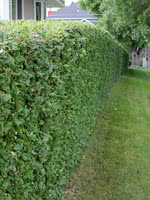Mon-Fri 9am - 5pm Mountain time
Peking Cotoneaster vs Wild Snowberry
Cotoneaster acutifolia
Symphoricarpos spp.
NOT AVAILABLE THIS SEASON - MIGHT RETURN
CUSTOM GROW
Peking Cotoneaster is a medium-sized shrub that is well adapted to colder climates. Best suited for use as a hedge, Peking Cotoneaster has dark green foliage that turns a stunning reddish orange in the fall.
Hardy fruit guru, Bernie Nikolai (DBG Fruit Growers), has started to recommend grafting hardy pear varieties to Peking Cotoneaster after his experiences were successful and produced fruit faster than other rootstocks. Remember to leave some nurse limbs if you try this.
Wild Snowberry is a mix of Common Snowberry and Western Snowberry. Each shrub's size, flower, and berry colour may vary.
This plant is abundant across the prairies. It can be planted alone or as a hedge in small yards. This shrub's ornamental berries persist into winter. Wild Snowberry can be a natural habitat and food source for various animals.
Peking Cotoneaster Quick Facts
Wild Snowberry Quick Facts
In row spacing: 0.3 m (1.0 ft)

